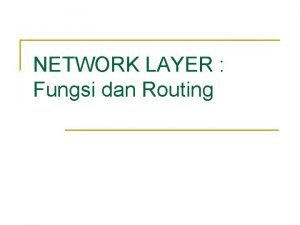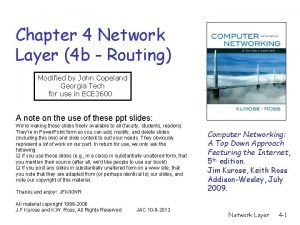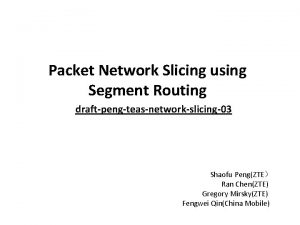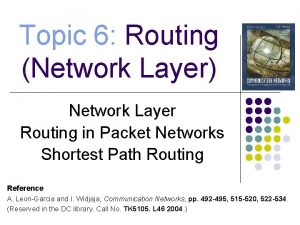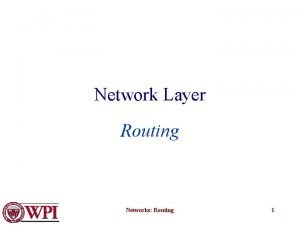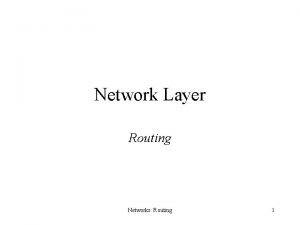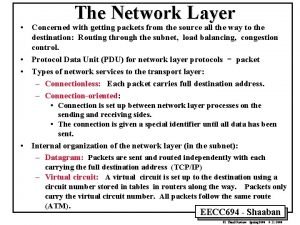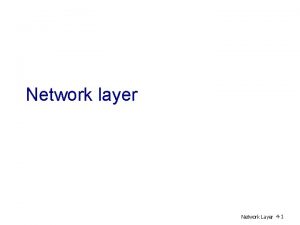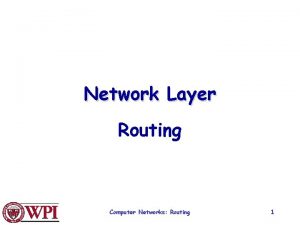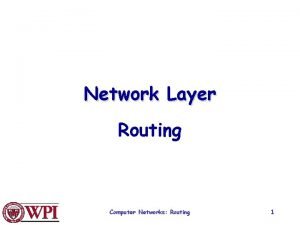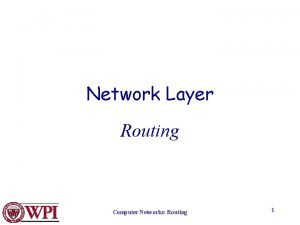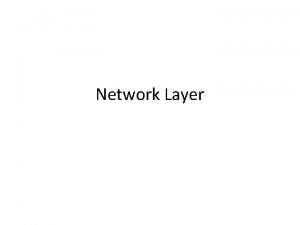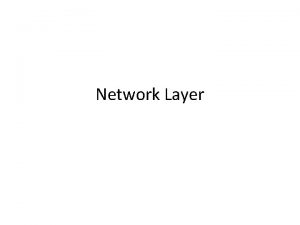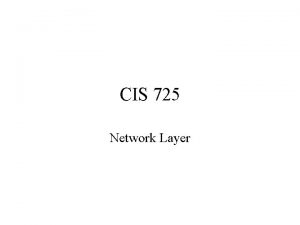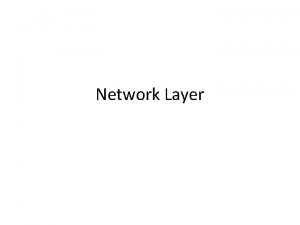Network Layer Routing Network Layer Concerned with getting











![Shortest Path Routing • Bellman-Ford Algorithm [Distance Vector] • Dijkstra’s Algorithm [Link State] Shortest Path Routing • Bellman-Ford Algorithm [Distance Vector] • Dijkstra’s Algorithm [Link State]](https://slidetodoc.com/presentation_image_h/0a54b371e53624f070884e3955e589b1/image-12.jpg)

![Internetwork Routing [Halsall] Adaptive Routing Centralized [RCC] [IGP] Intradomain routing Interior Gateway Protocols Distance Internetwork Routing [Halsall] Adaptive Routing Centralized [RCC] [IGP] Intradomain routing Interior Gateway Protocols Distance](https://slidetodoc.com/presentation_image_h/0a54b371e53624f070884e3955e589b1/image-14.jpg)


![Distance Vector Algorithm [Perlman] 1. Router transmits distance vector to each of its neighbors. Distance Vector Algorithm [Perlman] 1. Router transmits distance vector to each of its neighbors.](https://slidetodoc.com/presentation_image_h/0a54b371e53624f070884e3955e589b1/image-17.jpg)



- Slides: 20

Network Layer Routing

Network Layer • Concerned with getting packets from source to destination • Network layer must know the topology of the subnet and choose appropriate paths through it. • When source and destination are in different networks, the network layer (IP) must deal with these differences. * Key issue: what service does the network layer provide to the transport layer (connection-oriented or connectionless).

Messages Segments Transport layer Network service Network layer End system Data link layer a Data link layer Data link End system layer b Physical layer Network layer Copyright © 2000 The Mc. Graw Hill Companies Leon-Garcia & Widjaja: Communication Networks Figure 7. 2

Metropolitan Area Network (MAN) Gateway Organization Servers To internet or wide area network s s Backbone R R R S Departmental Server R S S R R s s s s Copyright © 2000 The Mc. Graw Hill Companies s s Leon-Garcia & Widjaja: Communication Networks Figure 7. 6

Wide Area Network (WAN) Interdomain level Border routers Autonomous system or domain Border routers Internet service provider LAN level Intradomain level Copyright © 2000 The Mc. Graw Hill Companies Leon-Garcia & Widjaja: Communication Networks Figure 7. 7

National service provider A (a) National ISPs National service provider B NAP National service provider C Network Access Point (b) NAP RA RB Route server LAN RC Copyright © 2000 The Mc. Graw Hill Companies Leon-Garcia & Widjaja: Communication Networks Figure 7. 8

Datagram Packet switching Packet 1 Packet 2 Copyright © 2000 The Mc. Graw Hill Companies Leon-Garcia & Widjaja: Communication Networks Figure 7. 15

Routing Table in datagram network Destination address Copyright © 2000 The Mc. Graw Hill Companies Output port 0785 7 1345 12 1566 6 2458 12 Leon-Garcia & Widjaja: Communication Networks Figure 7. 16

Virtual Circuit Packet switching Packet Copyright © 2000 The Mc. Graw Hill Companies Leon-Garcia & Widjaja: Communication Networks Figure 7. 17

Routing Table in virtual circuit network Identifier Output port Next identifier 12 13 44 15 15 23 27 13 16 58 7 34 Entry for packets with identifier 15 Copyright © 2000 The Mc. Graw Hill Companies Leon-Garcia & Widjaja: Communication Networks Figure 7. 21

Routing algorithm: : that part of the network layer responsible for deciding on which output line to transmit an incoming packet. Adaptive Routing – based on current measurements of traffic and/or topology. • centralized, isolated, distributed Non-adaptive Routing • flooding • static routing {shortest path}
![Shortest Path Routing BellmanFord Algorithm Distance Vector Dijkstras Algorithm Link State Shortest Path Routing • Bellman-Ford Algorithm [Distance Vector] • Dijkstra’s Algorithm [Link State]](https://slidetodoc.com/presentation_image_h/0a54b371e53624f070884e3955e589b1/image-12.jpg)
Shortest Path Routing • Bellman-Ford Algorithm [Distance Vector] • Dijkstra’s Algorithm [Link State]

Dijkstra’s Shortest Path Algorithm Initially mark all nodes (except source) with infinite distance. working node = source node Sink node = destination node While the working node is not equal to the sink 1. Mark the working node as permanent. 2. Examine all adjacent nodes in turn If the sum of label on working node plus distance from working node to adjacent node is less than current labeled distance on the adjacent node, this implies a shorter path. Relabel the distance on the adjacent node and label it with the node from which the probe was made. 3. Examine all tentative nodes (not just adjacent nodes) and mark the node with the smallest labeled value as permanent. This node becomes the new working node. Reconstruct the path backwards from sink to source.
![Internetwork Routing Halsall Adaptive Routing Centralized RCC IGP Intradomain routing Interior Gateway Protocols Distance Internetwork Routing [Halsall] Adaptive Routing Centralized [RCC] [IGP] Intradomain routing Interior Gateway Protocols Distance](https://slidetodoc.com/presentation_image_h/0a54b371e53624f070884e3955e589b1/image-14.jpg)
Internetwork Routing [Halsall] Adaptive Routing Centralized [RCC] [IGP] Intradomain routing Interior Gateway Protocols Distance Vector routing [RIP] Distributed Interdomain routing [EGP] Exterior [BGP, IDRP] Gateway Protocols Link State routing [OSPF, IS-IS, PNNI]

Distance Vector Routing • Historically known as the old ARPANET routing algorithm {also known as Bellman-Ford algorithm}. Basic idea: each network node maintains a table containing the distance between itself and ALL possible destination nodes. • Distance are based on a chosen metric and are computed using information from the neighbors’ distance vectors. Metric: usually hops or delay

Distance Vector Information needed by node : each router has an ID associated with each link connected to a router there is a link cost (static or dynamic) the metric issue! Each router starts with: DV = 0 {distance measure to itself} DV = infinity number {for ALL other destinations}
![Distance Vector Algorithm Perlman 1 Router transmits distance vector to each of its neighbors Distance Vector Algorithm [Perlman] 1. Router transmits distance vector to each of its neighbors.](https://slidetodoc.com/presentation_image_h/0a54b371e53624f070884e3955e589b1/image-17.jpg)
Distance Vector Algorithm [Perlman] 1. Router transmits distance vector to each of its neighbors. 2. Each router receives and saves the most recently received distance vector from each of its neighbors. 3. A router recalculates its distance vector when: a. It receives a distance vector from a neighbor containing different information than before. b. It discovers that a link to a neighbor has gone down.

Routing Information Protocol (RIP) • RIP had widespread use because it was distributed with BSD Unix in “routed”, a router management daemon. • RFC 1058 June 1988. • Sends packets every 30 seconds or faster. • Runs over UDP. • Metric = hop count • BIG problem = max. hop count =16 RIP limited to running on small networks • Upgraded to RIPv 2

Link State Routing Algorithm 1. Each router is responsible for meeting its neighbors and learning their names. 2. Each router constructs a link state packet (LSP) which consists of a list of names and cost for each of its neighbors. 3. The LSP is transmitted to all other routers. Each router stores the most recently generated LSP from each other router. 4. Each router uses complete information on the network topology to compute the shortest path route to each destination node.

Open Shortest Path First (OSPF) • OSPF runs on top of IP, i. e. , OSPF packet is transmitted with IP data packet header. • Level 1 and Level 2 routers • Has: backbone routers, area border routers, and AS boundary routers • LSPs referred to as LSAs (Link State Advertisements) • Complex due to five LSA types.
 Comparison of virtual circuit and datagram subnets
Comparison of virtual circuit and datagram subnets The secret to getting ahead is getting started
The secret to getting ahead is getting started Fungsi network layer adalah …
Fungsi network layer adalah … Flood routing types
Flood routing types Mark tinka
Mark tinka Continuity equation hydrology
Continuity equation hydrology Clock routing in vlsi
Clock routing in vlsi Routing and switching protocols
Routing and switching protocols Arg
Arg Layer 4 routing
Layer 4 routing Network slicing with segment routing
Network slicing with segment routing Fig 19
Fig 19 Brush border enzymes
Brush border enzymes Secure socket layer and transport layer security
Secure socket layer and transport layer security Presentation layer functions
Presentation layer functions Secure socket layer and transport layer security
Secure socket layer and transport layer security Secure socket layer and transport layer security
Secure socket layer and transport layer security Secure socket layer and transport layer security
Secure socket layer and transport layer security Layer 2 e layer 3
Layer 2 e layer 3 Layer-by-layer assembly
Layer-by-layer assembly Layer 2 vs layer 3 bitstream
Layer 2 vs layer 3 bitstream


